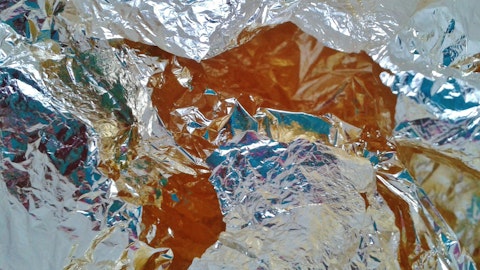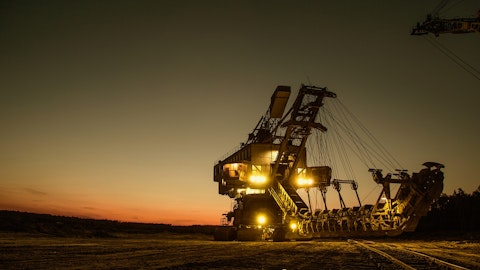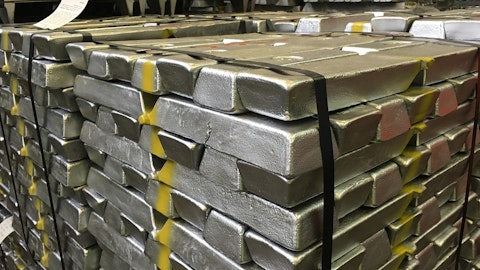Bold Baatar: Yes. No, look, I think the #1, I guess, objective for us is to work with the government of Guinea and the people of Guinea. It’s their resource, they work on their timetable, they have to get comfortable. So we’re going to take it one step at a time. We’re making great progress. We signed a term sheet in December, now in the final stages of definitive documentation. But it’s very important for agreements of this sort to have the utmost transparency and it takes the time for the right expertise to be provided to the government. So we’ll progress it as fast as we can provided, obviously, the Guinean Government is comfortable with.
Jakob Stausholm: And it goes without saying, all of you would love to have cost and schedule. As soon as we finalize agreements, we will, of course, update you all. But it’s impossible right now. The team is sitting in Conakry as we speak and are negotiating.
Danielle Chigumira: Just one follow-up in iron ore, that’s slightly different asset. So in the Pilbara, obviously, you saw significant recovery through the year. Last year, ended up at a great run rate. Could you give a sense like halfway through the quarter now and where you are relative to where you ended up last year? The iron ore — Pilbara iron ore run rate so far this year.
Menno Sanderse: So where we are now halfway through Q1 relative to where we were in Q4. So how are we doing operationally? Is the good trend of Q4 continuing to Q1?
Jakob Stausholm: Yes. No, look, I went there, as I said here, I’ve just been visiting a number of mines and spent 2 weeks in Western Australia. We came into the year in a very good — in a very good shape, really on all fronts, the assets were in a better shape than at the beginning of the year, the projects we finalized last year are working. We’re still ramping up on Gudai-Darri, but it’s working well. We haven’t had the most terrible weather so far. It’s — Q1 is always unpredictable, and I can’t tell you exactly how the weather is going to be in the rest of Q1. But we would not — Peter will not have presented a chart like the chart he presented today unless we felt that we are on a good trend here.
Menno Sanderse: Dom, please.
Dominic O’Kane: I had a question on the dividend. So Peter, I think you mentioned a modest shift in the dividend distribution in 2022. But I noticed that it’s the first year since you enacted the current dividend policy that you haven’t paid out more than 60% in total. So should we think about this as a reset towards your thinking towards excess capital distributions? And I suppose specifically, given where the leverage is and the framework for single-A credit, why didn’t you pay out more in this period?
Peter Cunningham: So I mean, Dom, we paid out exactly in line with our policy. So I think we’ve been really consistent there. In fact, we paid out at the top of that 60% of our policy. Now when we do that, then we go around and look at compelling growth, we look at the balance sheet and we look at additional returns. And I think this year, we certainly put money into what we see as compelling growth. I mean, the acquisition of the minorities of TRQ, Rincon, we’re keeping, investing in the OT underground. So that was where we put our money. The — actually, we paid out $8 billion, second half’s dividend, and that was on free cash flow of $9 billion. So I think you just expect us to be very consistent with how we apply the policy. And this year, we applied it absolutely at top of our range.
Menno Sanderse: Let’s go back to the phone for 2 questions. Operator, please question from the line.
Operator: The next phone question comes from the line of Amos Fletcher from Barclays.
Amos Fletcher: I had a couple of questions for Bold, and just complements on the Wi-Fi, by the way, very impressive. So on Oyu Tolgoi, I just wanted to ask on the project schedule, it would be helpful to get an update on how far behind schedule Shaft 3 and 4 are. Last time you mentioned, they are around 15 months behind relative to the 2020 technical report. Is that still your best working assumption? And any update on the CapEx as well?
Bold Baatar: Yes. Look, I think Shaft 3 and 4 are progressing really, really well. I think the one thing I would say, though, is that when we provided the schedule estimate at the time, it had estimated the shaft sinking to commence around June of ’21. I mean, reality is we had 9 months of delay. So it kind of gives you a sense of the challenge we face. And oftentimes, we forget COVID. COVID was still around in January of ’22. And at the time, there were restrictions on shaft sinkers to be actually to be able to travel. And so Mongolia did not allow inbound travel until, I think, April of ’22. So there was a timing of course, on how we manage. So that’s roughly — I think in terms of the productivity, I’m actually very pleased.
I was at the bottom of Shaft 3 and 4. Look, I think there they’re about 400 or 500 meters, 1,100 meters. The teams are making progress. But that is not our bottleneck. Our ventilation is sufficient. We’re working through, obviously, looking at what else to do in terms of mine planning and sequencing, primary crusher 2 and other things. So you should not assume that just because Shaft 3 and 4 that would be automatically that same commensurate delay in production. But everything that we do at the moment is on paper. The #1 priority for this year is to manage the cave and see how the cave propagates. So I just want to be really realistic that this is a year for learning for us, and we’ll build confidence as the year goes on.
Operator: And the next question from the phone line comes from Lyndon Fagan from JPMorgan.
Lyndon Fagan: I just wanted to talk about Slide 22, where you’re talking about doubling copper production. Do you mind walking through some of the projects to actually achieve that? And also, what is in that upside bar? And I guess specifically, can you talk about whether a plant expansion at OT is considered in all of that. I’ve got another question after that as well.
Jakob Stausholm: Bold.
Bold Baatar: Yes, sure. Look, if you look at the ’21 and ’22 production volume, they only had the 1/3 of OT in the numbers. So when you look at the future over 1 million tonnes of production for Rio Tinto, that obviously assumes the ramp-up of OT to 500,000-plus copper production. And to go from that ’21 low base, to over 1 million, 80% obviously, is OT. There is a growth coming from Kennecott potentially, but that is natural coming from the kit expansions. And potentially, we’re looking at the underground, but we don’t have at the moment the precise numbers to give you on the underground because we need to finish the feasibility study on that. As far as the next expansions, what it does not have, it doesn’t have Resolution, it doesn’t have Winu, it doesn’t have Nuton and any potential Escondida expansions.
So together with BHP, we’ll be obviously looking at that. The point I’m making is we have some of the best ore bodies in the world with Resolution, OT, Escondida. We have a number of opportunities for copper growth but we have to do it in a disciplined way. These are technically complex projects and we’ll take one at a time.





